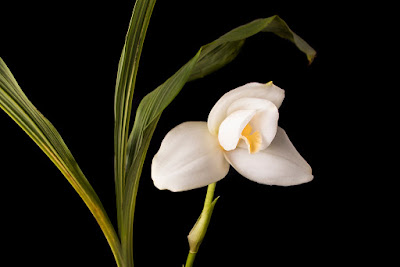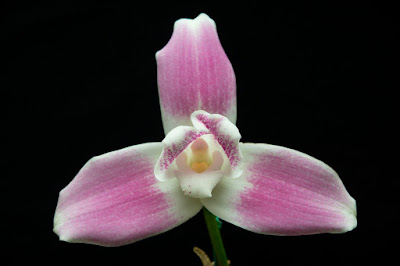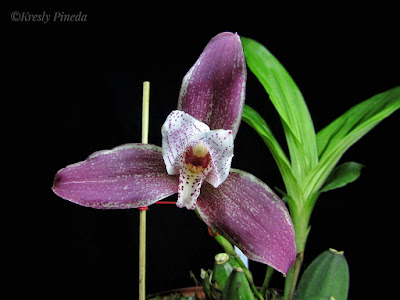Lycaste orchid have their ancestry in the cloud forests of Central and South America. The genus of approximately three to four dozen species is distributed geographically from Mexico south to Brazil. They grow mostly epiphytic on trees, less often lithophyte or just on the ground.
Lycaste orchid have their ancestry in the cloud forests of Central and South America. The genus of approximately three to four dozen species is distributed geographically from Mexico south to Brazil. They grow mostly epiphytic on trees, less often lithophyte or just on the ground.
IDENTIFY LYCASTE ORCHID PLANT
Lycaste orchid is a sympodial orchid, consisting of ovate (less flattened), single or trifoliate pseudobulb. The leaves are thin, wiry, keep only one year. Peduncles appear at the base of the pseudobulb (sometimes last year’s), most often only one flower per one peduncle. Flowers of unusual shape with dominant sepals. Petals, as a rule, are very small and are located almost perpendicular to the sepals, often of a different color. The lip is also relatively small. The flowers are from white to brown, ranging in size from 5 to 20 cm in diameter.
Lycaste species and hybrids are becoming popular for their large numbers of long-lasting flowers that offer a wide range of colors. Few orchids rival a well-grown flowering Lycaste plant, such as Lycaste skinneri, in flower size, shape and color. The myth that Lycastes are difficult to grow has been dispelled with the increased understanding of these plants' habitat and cultural requirements.
LYCASTE ORCHID PLANT CARE AND CULTURE
Cultural information should only be used as a guide, and should be to be adapted to suit you. Your physical location; where you grow your plants, how much time you have to devote to their care, and many other factors, will need to be taken into account. Only then can you decide on the cultural methods that best suit you and your plants.
Light:
Lycaste orchid loves bright sun without access to direct sunlight, so during the hot midday sun on the windows of the southern orientation and the hot evening sun on the western windows, this orchid should be placed behind the curtain (for example, on the table near the window) or in the shade of other plants. If the sun is too bright, the orchid reacts with yellowing of the leaves.
Temperature:
It is recommended to keep Lycaste orchid at home under moderate temperature conditions: Summer temperature at 18-24 ° C (maximum 30 ° C) in the daytime and no less than 10 ° C at night; Winter at 15-21 ° C during the day and 10-16 ° C (minimum 5 ° C) at night. For successful cultivation at home, it is necessary that the night temperature is always 4-10 ° C lower than the daytime.
Humidity:
Lycaste needs a relatively high humidity, its ideal rate should be 45-55% during the day and 90-100% at night. Too dry air has a negative effect on the development of the plant: its growth is inhibited, and the leaves begin to turn yellow and dry up prematurely. To increase the humidity of the air, you can use a humidifier, water saucers or wet clay. For this, a large pallet is taken, inside of which expanded clay is poured, a grate protecting the wetting of the roots is placed on top and pots with orchids are set up. The higher temperature, the higher the humidity should be, and the higher the humidity, the more often and longer it is necessary to ventilate the room where orchids are contained, otherwise there is a high probability of rotting and leaves of various kinds of fungal diseases.
Substrate, growing media and repotting:
This type of orchid mainly be grow in pots. Unlike many other orchids, the Lycaste roots do not require such a large amount of fresh air, therefore, as a substrate, you can use a mixture of leafy ground, bark of coniferous trees, beech leaves, fern roots, sphagnum moss peat.
In view of the fact that the roots of a plant are very sensitive to various kinds of salts contained both in ordinary tap water and in fertilizer, it is recommended to replant the plant at least once every 2-3 years. The best time to transplant is from March to May, when new orchid sprouts begin to build up their own roots.
Watering:
During the period of new growth, Lycaste orchid needs frequent and abundant watering. Excess water during irrigation should flow freely from the pot, since stagnation of water both inside the pot and in its pan can very quickly lead to rotting of the roots and lower parts of the plant. Especially sensitive in this regard are new sprouts of orchids. The substrate between waterings should dry up relatively well, but not completely dry, i.e. always in a slightly moist condition. Too dry maintenance of the plant during the development of new shoots leads to their deformation.
Fertilizer:
Regular feeding is an important component of caring for this type of orchid, as the plant annually renews its entire leaf cover and especially in the period of development of new sprouts it needs a constant inflow of nutrients. With insufficient nutrition pseudobulb orchids grow very small and do not bloom. During the period of new growth fertilize this type of orchid every 2 weeks in the usual concentration of fertilizer indicated on the package. In addition to the usual root feeding, it is also recommended to produce foliar, when the outer part of the plant is sprayed with very diluted fertilizer. It is best to feed the orchid, alternating between these two methods. Since conventional fertilizers for indoor plants are oriented for use in ordinary soil and when used in bark-based substrates, most of the salts accumulate by dead weight in the substrate itself, creating an environment unfavorable for the root system of orchids, leading over time to their massive burning. At the beginning of the growing season (the emergence of new sprouts), it is recommended to use fertilizer with a high nitrogen content, and by the time new sprouts reach 1/2 of its normal size, fertilizer with a high phosphorus content.
Rest period:
Due to the peculiarities of the climate in the homeland of this orchid genus during the winter period, Lycaste undergoes a cool rest period. Since December (after the plant has discarded leaf cover), orchids are placed on the brightest place and kept at a temperature of 15 to 21 ° C during the day and around 10-16 ° C at night and do not fertilize. Watering orchids needs to be coordinated with respect to lower temperatures and to produce a little bit more than once a month, avoiding very strong wrinkling of young pseudobulbs. In early March, the dormant period ends and the total temperature of the content rises.
Most of the hybrid representatives of this group of orchids can be grown without any rest period. In the winter, it is enough for them to provide a colder night temperature and coordinate watering with respect to these conditions so that it is always slightly wet, but not wet.

















COMMENTS